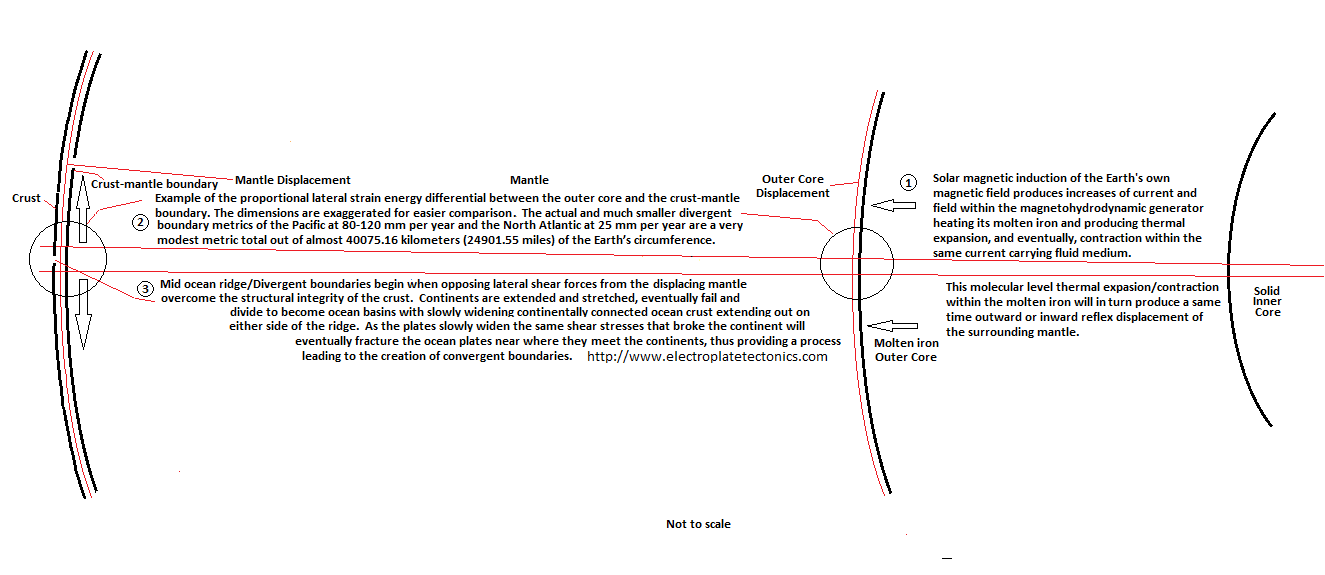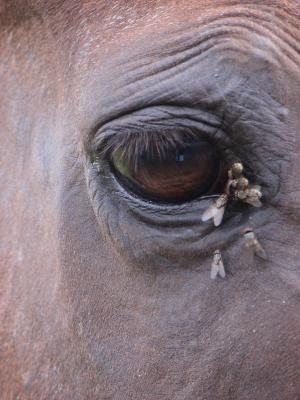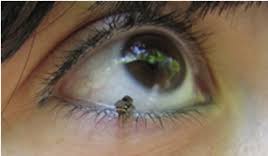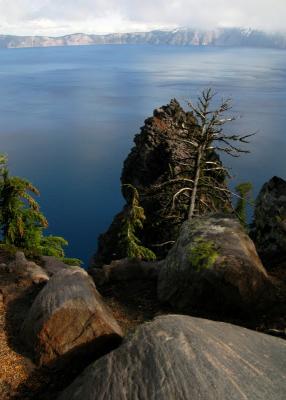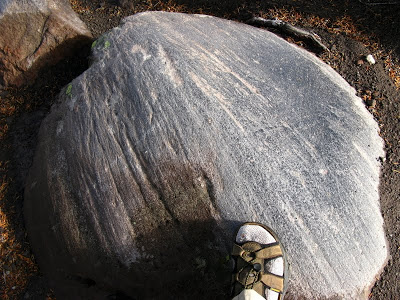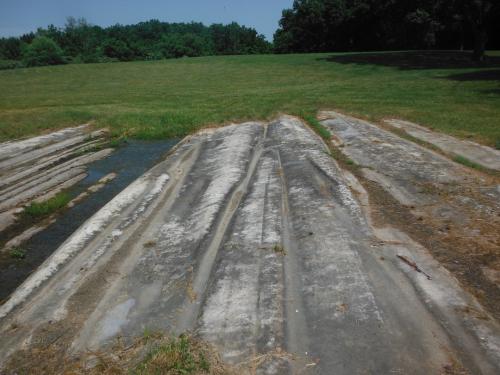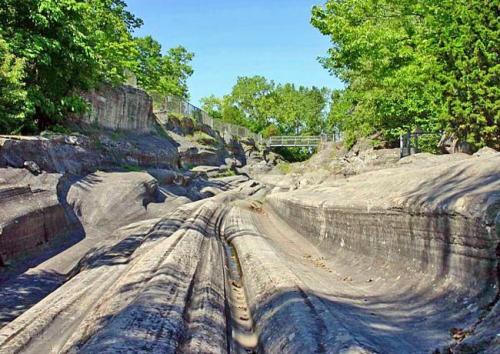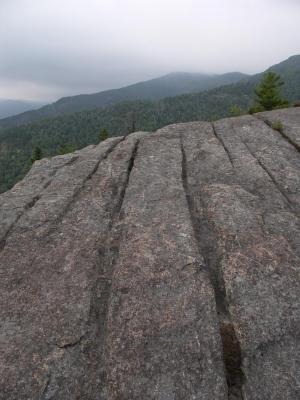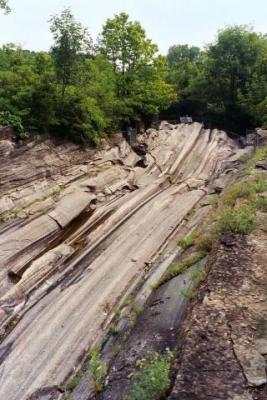-
Posts
978 -
Joined
-
Last visited
Content Type
Profiles
Forums
Events
Everything posted by arc
-
-
Your welcome. I look forward to seeing what you find. Digging a hole in the ground and looking at the night sky with a telescope are the only two "Time Machines" that anyone can own and operate.
-
I've got a few questions; 1. How far is the sink hole from the street. 2. Does the street have curbs and storm drains. 3. Is this neighborhood older than thirty years. Years ago I purchased a fixer-upper built in 1920 that had been hooked up to the district sewer in the late 1950's or early 60's. The line ran down the side of the house from the street. The surface above it had been a graveled driveway before and after the installation of the line. The driveway had been slowly raised with added fill material over the years by the previous owner and I had assumed it was to prevent the surface water from the street coming onto the driveway. In preparation for paving the driveway I remove around 30 cm of material and continued to drive on the area. One day I pulled onto the driveway in my Toyota Corolla, pressed on the brakes and felt the whole left side of the car drop to the ground as if the wheels had fallen off. I had collapsed the surface into the old ditch. I had just enough clearance to back out and examine the results. I could see where the original fill material had settled approximately 30cm, leaving a dome shaped cavity running the entire length. Some properties have easements that the local water dept use. Some of these service lines are quite large. The ditches are usually back filled with crushed rock to inhibit corrosion and prevent post burial settling of the over laying and under laying fill material. Fill material will settle even after the compaction done during the installation work. Older lines did not get as good of compaction as the more recent installations do. Mechanical and hydraulic machinery have greatly improved the process. Its possible these cavities could provide a place for surface materials to migrate into over extended periods of time. I think its time to do some testing of the site. Can you probe the area with a small diameter rod to see if a hollow area exists there or adjacent to it?
-
I viewed both videos, that first one reminds me of the standard, and sadly effective, Scientology propaganda. Those testimonials that start around 18:00 are spot on of Scientologist fair. "OOOW, I'm so much more aware now!" . . . . "I feel so much more intelligent!". . . . Blah Blah Blah.
-

Why do flies always try to land themselves in your face in the summer?
arc replied to james_pain's topic in Biology
Back when I was a kid we had some ponies and later a horse, the flies would always go for the animals eyes, nose and mouth looking for any moisture they could find. http://insects.about.com/od/HouseholdPests/f/Do-Flies-Really-Vomit-And-Poop-When-They-Land-On-You.htm By Debbie Hadley Insects Expert . . . . "Unfortunately for the house fly, it is not equipped to chew solid foods. Most insects that feed on solid food – beetles, for example – have chewing mouthparts, with which they can properly masticate their meals into tiny, digestible bits. House flies were instead blessed with sponge-like tongues. Only in flies, we call their tongues labella (the singular is labellum, but the fly has a matched pair)." "House flies "taste" with their feet . . . . . When a house fly comes upon something that seems like it might be yummy (keep in mind that dog poop is the kind of thing house flies find yummy), it will reflexively stick out its labella and press it against the potential food item to investigate. Liquids can be slurped up without much effort. Inside the house fly's head is a structure called a cibarial pump (or food pump), which generates a suction to draw the liquid up through channels in the mouthparts (called pseudotrachea). So how does the house fly make a meal out of meat, or any other solid food (like dog poop)? It uses those same mouthparts to liquefy the entrée." "The house fly dabs the tasty morsel with digestive enzymes by bringing up a little regurgitated food and saliva. The enzymes begin breaking down the solid food, gradually turning it into a slurry the house fly can then lap up. Meat milkshake, anyone?" "Now, think about the last time you had a stomach flu. Anytime you vomit repeatedly, you run the risk of dehydration, so you have to drink a lot of fluids to replace the ones you lost. Flies are no different. This liquid diet means flies require a lot of water. And when you drink a lot of water…well, let's just say what goes in, must come out, right? So flies do a lot of defecating, too." The CO2 is likely what allows the flies to locate the animals which then provide the needed moisture through their eyes, nose and mouth openings. With their hydration needs satisfied they can then dine, mate and then lay their eggs on the surrounding feces that these one-stop fly supply emporiums provide. And when they cannot find a horse or elephant or lion they will settle for us. -

You know whats funny about this "SCIENCE" forum?
arc replied to Elite Engineer's topic in The Lounge
Have you considered it may help prevent the politicization of the "other science sections", much the way the religious section appears to perform the same function. -

First Americans were stuck on Bering land bridge
arc replied to Itoero's topic in Evolution, Morphology and Exobiology
Yes, you are right, the use of the term Polynesian is very wrong in what I was referring to, I'll let rangerx defend himself. I would think though that whatever group name you would ascribe the earliest users of inter-island transportation within in the Pacific island archipelagos, they would find themselves occasionally "migrants at large" given the currents available. Although survival would seem a long shot at best. I couldn't find any dates older than possibly 6000 BC; https://en.wikipedia.org/wiki/History_of_the_Pacific_Islands "In the history of Vanuatu, the commonly held theory of Vanuatu's prehistory from archaeological evidence supports that peoples speaking Austronesian languages first came to the islands some 4,000 to 6,000 years ago." The farther north you check, though, the farther the dates go back; https://en.wikipedia.org/wiki/History_of_the_Pacific_Islands "In the history of Taiwan, Aboriginal peoples ancestors are believed to have been living on the islands for approximately 8,000 years before major Han Chinese immigration began in the 17th century." But I would think they wouldn't be considered a proto-Polynesian group, would they? So none of these get close to the date of the scenario I suggested for supporting rangerx's post; I would be curious where that; "proto-Polynesian, having arrived by boat 14,000 years ago." hails from. -

First Americans were stuck on Bering land bridge
arc replied to Itoero's topic in Evolution, Morphology and Exobiology
Although the Polynesians are in my opinion the greatest seafarers to date they would undoubtedly push their luck or find themselves in unexpected situations beyond their control. I can imagine a group of proto-Polynesians finding their way to northern waters as the last glacial came to an end and unfortunately finding themselves getting caught unprepared by the Younger Dryas or one of its predecessors. -

First Americans were stuck on Bering land bridge
arc replied to Itoero's topic in Evolution, Morphology and Exobiology
Is there genetic evidence supporting this? Many migration hypotheses have been thrown out solely on the lack of genetic support, Thor Heyerdahl's opinions for example. -
How do you propose to differentiate the dynamic effects, that are inherently present, when you "rotate the disc to as higher RPM as possible", from those "measure(ed) force(s) exerted on the underside of the disc in the upward direction", and the "force(s) exerted on the top side of the disc in the downward direction" ?
-
Thanks Strange, I thought it was a political advertisement at first, but its location within what I would consider the users "personal data" space would seem to me as a bone-head move for Google to make. So I'm thinking its some kind of uninvited push poll or maybe a virus infested link. But wouldn't that be difficult to place in such a location without Google detecting it? I guess I worry to much!
-
My wife's share of the bedroom closet as compared to mine.
-
I'm sure your first reaction will be that I'm bull . . . .ing you. But I'm not! I added Google Analytics to my Weebly hosted Electroplatetectonics.com site about a month ago. This morning I found a "vote for Trump" on one of the pages. Is this from someone in Google or is it some kind of a hack? I know very little about how this computer stuff works, if it wasn't for one of my sons technical help I would be lost when things on my laptop get screwed up. Where do you think this comes from? It's weird that it shows up on the language page but doesn't say which one. There has been one session from Samara, Russia. Could it be some scam from there? How would they get through Google's defenses?
-
Hello wheel, and welcome. To make this easier to follow let us refer to the positions on the wheel as in terms related to the numbers on the face of a clock. The increase of torque that your machine hopes to utilize through gravity at the 9 O'clock position is theoretically at maximum due to its tangential position to the force of gravity. This assumed momentary gain is unfortunately countered by the simultaneous movement towards the center of the balls at 3 O'clock. The loss in energy in this system, that cancels this assumed gain in torque, is when the balls move inward they also proportionally slow down in relation to the wheels rotation. (relative to rotation) This loss of momentum by way of decreased velocity of a portion of the rotating mass is directly in opposition to your gain in assumed torque. So you end up with a net loss of energy. Children on a swing will shift their center of gravity to utilize this torque you refer to. They are of course using their own (outside) energy to facilitate the gravity's energy to overcome the losses in the system. You would need to start your wheel with outside energy. Friction within the system tips the forces of nature against you and your wheel will slowly come to a stop.
-
I believe we can resolve this debate with close examination of the examples and scenarios that have been presented so far. Chimpanzees display what could be considered is the most basic interpretation of a tool; a stem used to withdraw termites from a mound. This activity along with other similar displays has not so far lead to a revolution in chimpanzee tool culture despite the chimpanzees having what would be the most important precursor to any tool making endeavor, a reasonably comparable brain to that of our earlier ancestors and two opposable thumbs. Although we don’t know when this termite extraction practice began for chimps, it did not lead to a series of extrapolations of the original idea, but merely the use of any suitable stem being stripped of obstructions. The first tool that the chimps originally utilized was most likely a found item and used as is and then copied through trial and error for generations after. So, despite having what would seem as a good starting platform consisting of a brain of adequate intelligence to ascertain a possible use for a tool, and opposable thumbs to shape and use it, why haven’t they demonstrated what could be considered a measurable awareness of the fact that many of the materials and objects in their environment can be used and modified to their benefit? Does a bird building a nest garner their interest? Can they learn from their environment? Have they discovered what the sharp edge of a fractured stone can do? And then tried it in a multitude of situations? The one very obvious attribute that they are missing is speech. And more importantly; what a speaking culture provides, a learning environment that enables and develops abstract thought processes. A sharp edge stone to a mind that is capable of abstract thought is the beginning of a cultural revolution. What would initiate the early development of the physiology in chimps that would lead to a gradual and meaningful increase in vocalization like that which occurred in early human ancestors? The apes all vocalize to some degree, no doubt like our early human ancestors must have, but at some point the resultant stimulation in cognitive intelligence of this activity in our ancestral groups lead to the greater survival and reproductive success of those involved. This feedback rewarded those that possessed the physiology of improved speech capabilities that then in turn spurred increased cognitive understanding and abstract thought capabilities. Even those within the group that evolution may not have chosen for this trait would have undoubtedly benefited from experiencing the results as a member. As the vocal physiology was passed down and selected by survival and reproduction the feedback cycle would assure this advantage would continue to strengthen though generations of successful reproduction. This is why I believe tool development was not the driving agent for our ancestors’ unprecedented mental development. The chimpanzees’ meager advancements in this matter are rather hard to reconcile. They lack even the most basic level of abstract thought, tools can be found and/or modified to perform a task and this knowledge passed on through demonstration, but without the ability to imagine objects in different contexts and more importantly share that context verbally, the chances of a tool culture developing without speech would appear to be slim. But more importantly how would this tool making and use wire a child’s brain for creative thought? Are these tool utilization moments really numerous enough to provide the needed learning environment to the group’s offspring? We Know now how important stimulating and imaginative environments are for developing children and how much more capacity they have as adults if their environment growing up was filled with stimulating social contact. This is why I believe the social model is so much more able to adequately explain this incredible anomaly that we undoubtedly are. There simply needs to be a feedback mechanism within this social group that promotes the use of abstract thought on an unprecedented level of circular reinforcement.
-
Bold mine. I believe the social hypothesis is the strongest of the two, in the early education of our own children we concentrate heavily on communication development which leads their demonstration of creativity by a appreciable degree of time. I believe the mental development of our early ancestors was the result of a informational feedback cycle of learning. This all began within a singular cultural group that quickly advanced through language and story telling. I described it several times before in other similar discussions on this forum. The creativity seen by the development of tools is a byproduct of the development and expansion of our early ancestor's brain capacity for abstract thought, an ability developed through imagining stories told within the group. I think the first human language, more than just those single proto words sounded when gesturing while hunting for example, but the first constructs of language began when our very early ancestors became aware of time, the first understanding of the concept of yesterday, today and tomorrow. I have debated whether a past/present/future awareness would have been in place prior or would it have developed in tandem with language as simply a tool they constructed to communicate more clearly. It would seem to be a natural development in language, to refer to for example, what happened on a hunt, and then extend those "stories" out over time. And with these early humans, that knowledge of past/present/future makes way for experiences of regret and hope that could develop into primitive religion and then into philosophy. This to me is possibly the driver of our brain evolution. Those who could communicate and imagine the images in stories and use that information could understand the world around them better and improve their chances to survive. This could be the engine that would progress brain development quickly. I could see it being almost inevitable that once the concept of the past is understandable, a hunter injured for example, would contemplate that traumatic moment and feel the regret of the mistake. He would possibly reexamine the events leading up to the accident searching for a answer to his regret. These experiences would lead to either fear or hope for tomorrow depending on the severity of his wounds and his knowledge of the fate of others with similar injuries. If the injured had been considered one of importance this could be quite traumatic for all those involved. This would likely create fertile grounds for superstition and the need to anticipate the possible dangers lying in wait for them tomorrow. This is an inevitable byproduct of increasing brain size. The increase of imagination that visualizes the stories with increasing complexity would also drive the superstition that would increasingly be included in those stories. Those that could process this flow of information and apply it to survival would likely pass their more advantageous brain and possibly even their cultural "education system" of language and stories on to their offspring. This model of evolution is one that has an internal mechanism of an information feedback creating an accelerated development of brain size in human ancestors. I think language, the concept of past/present/future and the stories that advanced human understanding, developed together through mutual reinforcement, accelerating our ancestors development.
-
I believe it is inherently tied to the development of language. language required our ancestor's brains to develop the abilities to visualize abstractly, to find new ways to describe what the thinker was trying to communicate. The process has directly improved itself in quality and quantity of information since the first utterance all the way to the present. The process of mankind's development and improvement of language moved continuously towards, and then in conjunction with mathematics, the abstract representations of the number of animals seen over the nearby hill as represented by the scouts upheld fingers would require improvement when numbers exceeded fingers and words lost their preciseness to quantity. Mathematics is and probably will always be the most precise and concentrated form of information man will ever discover/devise.
-
The author proposes the misguided sexual attraction of a male beetle for large beer bottles as a model of how other, and even more complex organisms perceive reality. CONCLUSIONS . . . . ."I suspect that few experts will be persuaded by these arguments to adopt the interface theory of perception. Most will still harbor the long-standing conviction that, although we see reality through small portals, nevertheless what we see is, in general, veridical. To such experts I offer one final claim, and one final challenge. I claim that natural selection drives true perception to swift extinction: Nowhere in evolution, even among the most complex of organisms, will you find that natural selection drives truth to fixation, i.e., so that the predicates of perception (e.g., space, time, shape and color) approximate the predicates of the objective world (whatever they might be). Natural selection rewards fecundity, not factuality, so it shapes interfaces, not telescopes on truth [28] (p. 571). The challenge is clear: Provide a compelling counterexample to this claim." Bold mine it's interesting. The beetle's predicament is almost identical to that of the thynnine wasp. http://www.fs.fed.us/wildflowers/pollinators/Plant_Strategies/mimicry.shtml "The warty hammer orchid of Western Australia produces a chemical scent that is almost identical to the pheromone that the female thynnine wasp releases when she is sexually receptive. The orchid's labellum (lower lip) is also shaped similarly to the body of the female wasp. The male thynnine wasp grasps the imitation female and tries to fly off with her to mate and in the process crashes into the flower structure containing the pollen and the stigma. Pollen from one orchid is carried to another and pollination occurs. The male thynnine wasp's desire to mate as many times as possible lends to this trait of pollinating the warty hammer orchid." Large game hunters commonly use pheromones and the sound of rutting males fighting to fool their prey. Deception is well established within the species. It is also interesting that humans have developed deceptive counter measures; http://www.nytimes.com/1989/09/05/science/face-masks-fool-the-bengal-tigers.html "That finding was a matter of life or death in an experiment being conducted in the Ganges Delta in India, where tigers living under protection in a reserve had been killing about 60 people a year. Arguing that this predator only attacks people from behind, workers in the mangrove forests started wearing face masks on the backs of their heads. Thus far the trick appears to have worked." Then there is the propensity of some human males to attempt to mate with as many females as possible, and what seems to be the counter measure that the larger group established to reduce the likelihood that the resultant offspring would be dependent on the overall group in general. Yes the ultimate counter deception of all; a marriage covenant by oath in front of a deity and the other members of the group.
-
There must be a measurable build up of anxiety leading up to the events, the news and all, everyone running around getting stuff ready up to the arrival time. Not to mention the whole uncertainty about the exact path the hurricane will travel. Maybe some sort of pre-traumatic stress syndrome. Hang in there moon. You're in our thoughts.
-
Bold mine. Except for those on the wrong side of a major paradigm change. Scientists are as human as anyone and having your past body of work suddenly viewed from a new and revolutionary perspective that directly diminishes the relevance it had held in the years prior would produce a reactionary response in almost anyone in general. And even more so if your life's work may now appear to have been off the mark and misguided to some degree or your direction of study no longer appears as capable as before. https://www.uwgb.edu/dutchs/PSEUDOSC/SCICRANK.HTM Steven Dutch, Natural and Applied Sciences, University of Wisconsin - Green Bay Plate Tectonics - A Case Study "The paranoid tone of pseudoscience occasionally surfaces in the works of orthodox scientists; not, as one might expect, in the works of scientists who are trying to bring about a scientific revolution, but more often than not in the works of scientists who are resisting change. In the late 1960's and early 1970's, for example, as the opinion of most geologists was swinging in favor of continental drift (as it was still called), a few conservative geologists fought a rear-guard action against its acceptance. Interestingly enough, the more the evidence favored drift, so that one could be justified in referring to opposition to drift as pseudoscience, the more striking the parallels became between the writings of the anti-drifters and the tactics we see in other pseudoscientists. There was, for example, the familiar tactic of downgrading findings to the level of "hypothesis" or "speculation". And of course there were charges of ulterior motives and unscientific conduct." "Although the scientific knowledge of these writers is immeasurably greater, the rhetoric is scarcely distinguishable in tone from that of any other pseudoscientists. I was going to graduate school at Columbia University when these papers appeared. The Lamont-Doherty Geological Observatory of Columbia University was one of the research centers most heavily involved in the research that led to the confirmation of continental drift. The reaction of the Lamont scientists to the anti-drift articles was not so much anger as amused, open-mouthed incredulity that any scientist would actually put his name on something like that." Not that I've had any personal experience with this behavior from anyone here, mind you. BTW Steven Dutch's blog is worth the read.
-
I am rather limited in the incredibly wide range of scientific and engineering knowledge that is required to produce our current level of space faring craft, let alone something that could be thousands of years away in the future. Think of a similar conversational comparison with a passenger on the Mayflower imagining a ship like the Titanic just few hundred years later. Never mind what the original builder of the Mayflower would be able to estimate what the state of the art will be in 1912. We are rather blinded by our own generational cultural biases. The 1930's Buck Rogers was a viable speculation to countless movie goers the same way the 1960's Star Trek seduced my generation. We saw in that original craft the farthest reaches of that era's speculation of future possibilities. And with each additional revamp of the franchise the subtle adjustments kept the concept up to date and fresh in the same way the newest remake of the Corvette does to that automotive line. I would even venture that the most current rendition of the Star Trek Enterprise shares more in technological semblance with the Corvette than that far in the future assemblage of technology that would allow humans to travel between the stars. And it may, and most likely will require, there be as much technological advancement in human physiology as the vessel they will ride in. So much so, they might not resemble us in many ways. Such is the price we will pay to travel to the stars.
-
Hello studiot, Thanks for your information, that is interesting. I think I've seen that over the years in images but I didn't know the cause. Our area is part of the Pacific temperate rain forest of the Cascade Mt. Range which results in a substantial amount of rain derived erosion of the terrain and the tremendous volumes of biomass that these soils have produced that have combined to fill in the western lowlands. The eastern side of the Cascade Range is substantially higher and dryer than the west side and reveals much more of the basaltic base material that covers so much of this area. I would think there would be images taken over the years, just to the east of the range's crest, that would show evidence of these moving masses of ice. I have only so far found a few such images. I really like this blog BTW, she does some really good posts. https://highway8a.blogspot.com/2009/11/travel-day-three-part-3-crater-lake.html "I followed my geological instincts to this cliff edge, where I found some great glacial striations and grooves on some lava rock (possibly the andesite of Applegate Peak, which has a K-Ar date of 258±8 ka to the south - Bacon, 2008). The grooves point approximately toward the Wineglass - a northeasterly direction."
-
I have been looking for some images that show glacial flows that results in the sub-straight having similar (mirror) abrasive wear that matches my example. The ones in the image below appear to be twice or more in size than my example, but in looking at dozens of different example images it seems that these grooves can occur at a wide range of scales. Some of these sites are deeply channeled gorge-like areas where the walls and floor are grooved by the ice, rocks and undoubtedly a particle slurry made up of a wide range of particle sizes produced through the glacial processes that work to not only lubricate but help wear down both the moving rocks, termed glacial erratics, and the sub-straight alike. I wonder, and would suppose that these gorged-out areas began from a already existing low area that the dynamics of the ice being compressed into them accelerated the erosional processes. The continually steepening walls would move that slurry to the lowest areas and accelerate the removal of the base material. Even what appear to us as high areas were just low and of little consequence to the much more massive ice flows. I can almost see my little rock left stranded on that precipice (above) when the glacier retreated. Eventually wind and rain tipping it over the edge and it falling into the erratic filled valley below. Maybe that is where that big chipped off spot came from.

